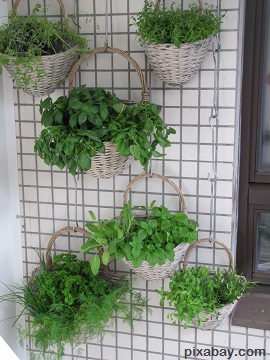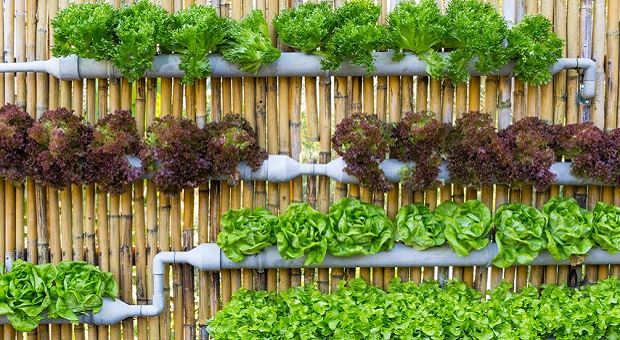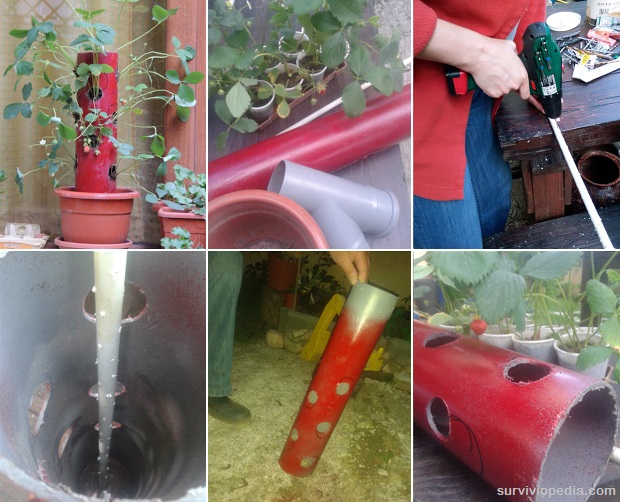Just because you live in a small place with little to no yard doesn’t mean that you can’t enjoy fresh vegetables and plants that you grow yourself.
Vertical gardening allows you to take advantage of every square foot that you have available to you.
For that matter, even if you have plenty of space, vertical gardening is a great way grow a variety of plants that you can eat and that decorate your yard. All you need is some latticework or something similar and the desire to do it!
Besides the fact that you don’t need much space for a vertical garden, there are other advantages, too. If you have problems bending down, a vertical garden allows you to pick the fruits and vegetables standing up or sitting in a chair. It also helps to keep plants free of pests and mold because they’re not laying on the ground. Finally, you don’t waste produce that ripens under the leaves and rots before you see it.
There are several different methods of vertical gardening and the ones that you choose depends mostly on personal preference and the types of plants that you want to grow.
Vining plants work wonderfully but you can also grow potted plants and even root vegetables if you want. Vertical gardens are beneficial to many plants, because they leave room for air to circulate, which helps prevent fungus and mold from growing on the plants.
Whether you’re just wanting to make a bare wall bloom with beautiful flowers or you’d like to grow your own food, you’ve found the right article. We’re going to discuss several different ways that you can grow whatever you want as long as you have a wall, or even some sort of framework or a fence.
Since even edible plants are beautiful, start with the wall that you like the least. What you want to grow here is going to determine how you start, so let’s talk about the different plants that do well with vertical gardens.
Vining Plants
Plants in this category include tomatoes, grapes, beans, peas and squash. All of these plants are easy to twine around anything from latticework to chain-link fencing so you have a lot of latitude regarding where you can grow them.
It’s a good idea to start the plants indoors a few weeks before the last frost if you’re growing them from seeds so that they are hardy enough to plant outdoors once the weather warms up. This also gives them a growth period that will allow some roots to develop so that they have a better chance at survival when you replant them.
If you’d like to grow ornamental plants, morning glories, jasmine and clematis “snowdrift” are all beautiful plants that will cover a wall, trellis, fence or gazebo in beautiful flowers and foliage.
Hanging Baskets

Because herbs grow quickly, you can start them right in the basket but you may want to start berries and other veggies indoors a few weeks before the last frost so that they have a head start on growth.
If you like squash but don’t have to room for traditional vining ones, check out Butterscotch winter squash. You’ll get the delicious fruit but it has compact leaves and vines that grow well in containers. Each squash grows large enough to feed two people.
You can, of course, always grow non-edible but beautiful flowers such as petunias, pansies, hydrangeas, succulents and miniature roses in your pots, too.
To start a vertical garden using pots, simply tack up sturdy (REALLY sturdy) latticework or fencing to your wall or build a stand-alone wall, then hook the pots through the holes. You can even buy flat-backed pots in some places that make this task even easier. Just leave enough room between the pots to allow the plants room to grow.
Running Planters
Using this method of vertical planting requires fencing or a stand-alone wall strong enough to hold the planters but it’s a relatively simple way to start a vertical garden. Plants that grow well in planters include potatoes, peppers (which also do well in baskets), cucumbers, lettuce, melons and squash.
You’ll need planters, hooks and sturdy fencing. Also, make sure that the planter is deep enough to allow the plants to root – at minimum they should be 8 inches deep with holes for drainage. If you’d like to vary the heights and lengths of the planters so that you can grow the plants independently of one another, just buy different sized planters. This method looks pretty, too.
Start by drilling holes in the backs of the planters for the hooks and then hooking them to the fence. Chain link and hex netting are great depending on how strong you need it to be. Plant whatever you want to in them but be sure to leave enough vertical room for the plants to grow.
With all of these methods, you can still grow your vining plants among the baskets or planters as long as there is space enough to do so between the containers. That way, you get double the bang for your buck and use every square inch of space that you have available to you.
Tips
You don’t necessarily have to use a wall or a fence to grow a vertical garden; you can always stake a trellis or poles in the yard, too. Just make sure that they’re anchored well to keep the wind and weight of the plants from knocking it over.
If you’re having trouble deciding whether fruits such as melons would do well, a tip to keep in mind is that any fruit smaller than a volleyball will likely have a vine strong enough to support it.
When you’re planning your vertical garden, make sure that you research how much sun the plants that you want to grow require. Some do well in full sun while others grow best in shadier areas with partial sun.
PVC pipe makes a good trellis for heavier plants, baskets or even vining plants. Search the internet and you’ll find all kinds of cool designs. You can build them in arcs or in the shape of a tent, then grow plants that do better with partial sun underneath it in baskets or on the ground.
Plastic trellises are better if you’re planning a permanent vertical garden or one that you’ll use season after season because wood needs to be pressure-treated to keep it from rotting. Also, in my experience the wooden trellises that you buy at the store aren’t quite as sturdy as the plastic ones.
Remember that your plants are going to need to be watered so if you have wooden siding, you may want to put plastic sheeting behind it or place it somewhere else to protect your house.
Your vertical garden can be as simple or as fancy as you want it to be. It’s a great way to grow your own produce even if you have limited space and they’re also pretty to look at. Keep these tips in mind and happy gardening.
If you have any more tips about vertical gardening, please feel free to share them in the comments section below!
This article has been written by Theresa Crouse for Survivopedia.










Pingback:Vertical Gardening: Growing Food in Small Spaces | TheSurvivalPlaceBlog | July 13, 2015
|
Pingback:The Top 9 Most Nutritious Food For Your Survival Gardendisasterdefense.usdisasterdefense.us | disasterdefense.us | August 9, 2015
|
Pingback:The Basic List For Your EMP Survival | Survival skills, survival guns, survival guide | November 20, 2015
|
Pingback:The Basic List For Your EMP Survival | Prepper's Survival Homestead | November 20, 2015
|
Vertical Garden in Melbourne | November 27, 2015
|
Hi Admin,
I have been just watching your blog, It’s really Impressive. Just loved the information and content of this blog. If you are living in the city or a municipal place where there is narrow land available, then you should think about vertical gardening. You can easily prepare plants to grow vertically by using supports and frames. This will make it easy for the plant to grow vertically, as it is a expected process for them.
Keep writing the stuff like this.
Thanks,
Designer Plants
Pingback:City vs. Rural Bug In: How Do You Handle Your Reserves? | Survival skills, survival guns, survival guide | December 2, 2015
|
Pingback:City vs. Rural Bug In: How Do You Handle Your Reserves?disasterdefense.us | disasterdefense.us | December 2, 2015
|
Pingback:10 Things To Replace Power During A Blizzard | Survivopedia | February 5, 2016
|
Pingback:10 Things To Replace Power During A Blizzard | | disasterdefense.us | February 5, 2016
|
Pingback:20 Early Spring Edibles: How And When To Grow Them - Bio Prepper | March 22, 2016
|
Pingback:9 Ways To Grow Food On The Down-Low | | disasterdefense.us | April 18, 2016
|
Pingback:9 Ways To Grow Food On The Down-Low | Survivopedia | June 21, 2016
|
Pingback:How To Build A Portable Survival Garden | Prepper's Survival Homestead | July 14, 2016
|
Pingback:Small Spaces Survival: Growing Food Upside Down | Survivopedia | December 29, 2016
|
Pingback:Growing Food: What to Use Instead of Soil | Survivopedia | June 25, 2017
|
Pingback:10 Ways You Can Recycle Plastic Food Bottles | Survivopedia | September 18, 2017
|